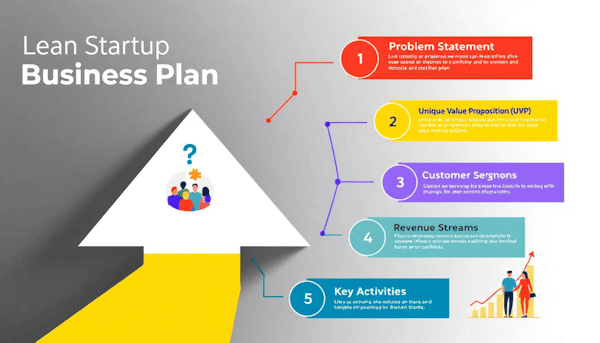Creating the Best At Home Business Plan: A Step-by-Step Guide

Want to start a home business in retirement? This guide will help you create a full at home business plan, covering everything from choosing the right format to writing key sections like market analysis and financial projections. A full business plan is essential for outlining goals, strategies, market analysis and financial projections which are needed for business loans.
Top Tips
- A business plan is a roadmap for success, operational management and funding for home businesses.
- Choose between a full business plan for detailed analysis and funding or a lean startup plan for quick adaptation to your business needs.
- Key sections include the executive summary, market analysis, financial projections and appendices, each helping you understand your business viability and strategy. And using business resources such as staff, capital and intellectual property is key to creating value for customers.
- The business owner should use key business resources to make the business plan actionable and aligned to the business goals.
Why a Business Plan is Essential for Home Businesses
Having a business plan is key to starting a business, it sets the foundation for future success. This document outlines your goals and strategies for your home business. A business plan is a roadmap.
Whether you’re offering services, selling products online, or other offerings, having a business account is important to keep personal and business finances separate for tax purposes. Additionally, maintaining a clear distinction between personal and business finances can streamline your financial management and ensure compliance with tax regulations.
A home business plan helps entrepreneurs manage the business and get funding. Lenders need a detailed plan to understand your market, business model and financial projections before they approve loans.
For sole proprietorships it’s important to understand tax and liability implications. A business plan also has strategies to help your small business grow, focusing on expanding operations and increasing revenue.
A good plan encourages ongoing evaluation and adaptation, helps long term success by helping you measure progress and stay on track with your goals. It can also attract business partners and investors by showing them a profitable partnership. Essentially a business plan is a living document that evolves with your business.
Choosing a Business Idea
When choosing a business idea for your new business focus on your passions, skills and experience as these will be the key to your business’s success. Do market research to test your idea and understand your potential customers needs so you can tailor your offerings.
Align your business idea with personal and professional goals so it resonates with your values and mission. A unique value proposition and competitive advantage will help your business stand out and attract and retain customers.
Consider the financials like startup costs, funding options and potential revenue streams so you have the resources. A business plan template will help you get your thoughts organized and create a structured plan that covers all the essentials.
Home based business opportunities that are viable are being a professional organizer, personal chef or pet sitter. A cleaning services business is viable due to growing demand and a photography business can attract clients through an online portfolio and social media. Additionally, offering online courses can be an excellent way to leverage your expertise and reach a wider audience from the comfort of your home.
Choosing the Right Business Plan Format
Choose the home business plan format that suits your business and goals by selecting the right one. Business plans fall into two categories: traditional and lean startup. Each has its strengths for different business types and goals.
Traditional business plans are long and cover financial forecasts and market analysis. These are for when you’re looking for big investment as they give a full picture of the business.
Lean startup plans are short, one or two pages, summarising the key bits of the business. This is for when you need to test the market fast and make quick adjustments based on feedback.
Traditional Business Plan Structure
A traditional at home business plan typically includes:
- Executive Summary
- Company Description
- Target Market Analysis
- Organization and Management
- Service or Product Line
- Marketing and Sales
- Funding Request
- Financial Projections
- Appendix
Traditional at home business plans are comprehensive documents that often reach dozens of pages in length. They’re perfect for presenting to lenders and investors who need detailed information about your business venture. The executive summary stands out as the most crucial section, as it briefly captures essential elements like your business concept, mission statement, and market opportunities you’ve identified.
In the organization section, establishing a proper legal entity such as an LLC or corporation is necessary to clearly define your business structure and legal responsibilities. When crafting your funding request section, remember to emphasize the importance of business insurance to protect your assets and ensure you’re compliant with industry regulations. For existing businesses, the financial analysis becomes particularly valuable. This section highlights your business’s financial health and potential assets, providing documentation and performance metrics that demonstrate your operation’s viability.
While creating traditional business plans requires time investment, they’re invaluable tools for securing business funding and providing a thorough roadmap for your company’s future. These detailed plans are especially well-suited for detail-oriented business owners seeking comprehensive planning documents or those actively pursuing financing options.
Lean Startup Business Plan Structure
A lean business plan is a summary of the most important home business bits, done in about an hour and on one page. It covers value proposition, infrastructure, customers and finance, so you can test the market quickly and adjust fast. Using an ecommerce platform can help you test the market and adjust even faster as these platforms have the tools to create and manage online businesses.
A lean business plan should define customer segments for a target market approach. Knowing your target audience allows you to tailor products or services to their needs and increase your chances of success in the market.
The lean startup approach is all about experimentation, viewing failures as learning opportunities not setbacks. This mindset allows for quick pivots and adaptation to changing market conditions, perfect for fast paced industries.
Crafting an Executive Summary
The executive summary of your plan is a snapshot of your home business, mission, product, leadership and financials. This will convince the reader of your business and your management team.
A good summary should include a mission statement, product/service description and financial growth summary. Write this section last after you have completed all other parts of the business plan so you can include all the necessary information and an accurate reflection of the whole plan, in a nutshell all the key business info and strategies. For accurate financial projections, you need to consult a certified financial planner as it shows expertise and credibility and will give you a reliable financial outlook.
Detailing Your Company Description
A good company description should state the business name, ownership structure and the people involved. This should answer the 5 W’s (who, what, where, when, why) and 1 H (how) to explain the purpose of the business.
Include location, key people, structure, ownership percentage and company history. What problems does your business solve and what’s your advantage over the competition? If family members are involved in the business, make sure to define their roles so you can maintain a balance between personal and business life.
Your plan should include a mission statement explains your home business goals and unique value proposition, a vision statement explains the long term goals and direction of the business. Update the company description regularly as the business evolves. Additionally, clearly articulating your company’s core values can help align your team and attract like-minded business partners and customers.
Setting Clear Business Goals
Setting clear, measurable, realistic marketing objectives is key for tracking success. A detailed marketing plan aligns these objectives with strategies to attract and retain customers. Identify priority marketing programs to focus on strategic growth themes. Connect business goals with performance indicators to justify their importance.
Strategy maps help clarify the relationship between goals and measurable outcomes. Regularly review marketing objectives and strategies to maintain relevance and effectiveness. Customer satisfaction metrics align business aims with consumer expectations. Consider internal processes when setting goals for a balanced approach.
Describing Products and Services
This section explains what you offer, how it benefits customers, and how it’s created or obtained. Include an explanation of your product/service, pricing model, typical customers, and supply chain.
Highlight the unique features or advantages over competitors so customers know why they should choose your offering. Outline your pricing strategy and how it compares to the market. If offering tutoring services, discuss fulfillment methods, in-house or outsourced, for service delivery.
The dropshipping business model allows individuals to market and sell products without holding inventory, so operations are streamlined with lower upfront costs. This model has minimal financial risk and allows you to target niche markets, making it a popular choice for many entrepreneurs.
Mention certifications or intellectual property like trademarks or patents that add credibility to your product or service description. Discuss future expansion possibilities to show growth areas. A landscaping business, for example, can offer garden design, irrigation, and stone work, making it a profitable business. Consider also how technology can enhance your service delivery, such as using an ecommerce platform to reach a broader audience or incorporating digital tools for efficiency.
Conducting Market Research
Market analysis requires you to understand what’s happening in your industry and take a close look at what your competitors do well or poorly. You can gather effective research using existing information sources or by directly engaging with consumers through surveys or focus groups, which give you deeper insights into what specific customers really want.
Getting to know your customer demographics helps you spot both opportunities and challenges when trying to attract clients. Figuring out your market size helps determine how many potential customers are out there. Good market analysis shows whether people actually need what you’re selling and helps identify who might buy from you. Also, don’t forget that protecting customer data is essential for following legal rules and keeping your customers’ trust.
When writing your market analysis section, make sure to explain who your competitors are, what they’re good at, and where your business has advantages. When you spot trends and patterns during your research, use these insights to guide your business decisions toward strategies that will work better in the real world.
Developing a Marketing Strategy
A marketing and sales plan outlines how to get and keep customers, the sales process and retention strategies. Branding differentiates your business and tells its purpose.
Think about branding elements like logo, color scheme and advertising strategy. An action plan outlines steps, timing, resources and budget for marketing tactics.
Digital strategies for home businesses include SEO, content marketing, social media, email marketing and pay per click advertising. Platforms like Facebook Marketplace and online marketplaces are entry points to sell products, an online store is a direct sales to customer. Social media posts are key to visibility and readership, other promotional methods like podcasts, webinars and newsletters.
A marketing plan must be flexible to suit your needs and evolve over time. For home businesses local SEO and multi channel communication is key to reaching your target market.
Performing Financial Analysis
Financial goals are to reduce costs and increase revenue. A profit and loss statement (P&L) is a summary of revenue and expenses over a set period, usually monthly, quarterly or annually. Managing overhead costs is key to increasing profitability, as lower overhead costs can make a big difference to a business’s financial health.
Existing businesses should have income statements, balance sheets and cash flow statements in their financial analysis. Balance sheets give a snapshot of assets, liabilities and equity to assess financial stability. Cash flow statements show actual cash flow to understand liquidity.
Regularly reviewing financial statements helps you see trends, areas to improve and inform decisions. Using accrual accounting allows you to record income when earned and expenses when incurred to get a clearer picture.
Making Financial Projections
Financial projections are key to getting funded and proving your business is viable to investors and creditors. These should cover 3-5 years and include income statements, balance sheets and cash flow statements. The Small Business Administration has great resources to help you create these financial projections.
When estimating expenses and revenue use researched estimates and consider how expense changes impact other projections. For example if marketing expenses go up, reflect that in revenue projections to see the profitability impact.
Funding requests should state the amount needed and how it will be used to align with financial projections. This clarity will build credibility with investors and lenders, showing you have a thoughtful and realistic plan for how you will use the funds to grow your business.
Summarizing Operations
The organization and management section gets to the heart of what makes your business tick, and who’s behind it. That unique experience and expertise your team brings to the table is what drives business success.
Your operations plan should cover the basics: staffing, location, office space, equipment, technology and software needs. A dedicated space for clients—where they can feel at home—is a big part of what makes your business look and feel professional. And that, in turn, enhances your service capabilities.
To really scale and manage your business effectively, you need to be able to hire the right people at the right time. Clear timelines and milestones help you track progress—and hold yourself accountable. Highlighting what sets your employees apart—through their resumes, for example—can be a major competitive advantage.
The appendix is where you can include supporting documentation that makes your business plan even stronger: employee resumes, building permits, equipment leases. That way, everything is in one place.
Implementing Your Business Plan
Pay attention to detail. Prioritize, define goals, create a timeline and you’ll be on track. Business owners bring the plan to life. Refer to the plan regularly to stay on strategy and adjust as needed.
Get funding through loans, investors or personal savings to support growth initiatives. Hire employees and build a strong team of great people and you’ll be more capable and successful.
Have a separate business bank account to keep personal finances separate from business finances. Your accounting will be simpler and more accurate. Having a dedicated office space will help you stay organized and productive.
Create a full marketing strategy that includes social media and content marketing to reach your target audience. Be flexible and open to new opportunities and challenges, adapt to change to stay competitive in a changing market.
Monitoring and Evaluating Progress
Review your financials to see where you can improve, track website traffic, social media engagement and customer acquisition. Do market research and analyze customer feedback to refine your strategy and make data driven decisions. Update your business plan to stay ahead of the game and achieve your goals.
Celebrate your wins and learn from your failures to stay motivated. Get advice from mentors or peers for insight. Stay up to date with industry trends and regulatory changes to stay competitive and compliant. And don’t forget ensuring data protection is key to compliance and operational efficiency when running a home based business.
Continuously optimize your operations, supply chain and customer service to increase efficiency and satisfaction. Review your business plan regularly to prepare for new challenges and opportunities.
Including Additional Information
The appendix is where you store supporting documents requested by readers. Common items are credit history, resume, product pictures, letters of reference, licenses, permits, patents, legal documents and contracts.
Include a table of contents if you have many documents in your appendix for easier navigation. Consider a confidentiality statement if you have sensitive info. Having all your documents in one place adds credibility to your business plan and makes it easier for readers to understand and trust your projections and strategies. Entrepreneur Press has many resources and guides for starting a business that can be very helpful for you.
Summary
You need a detailed comprehensive business plan for your home-based business to succeed. From business structure to products and services to market research and marketing strategy, each piece is crucial to your business. There are many resources and support systems for small businesses, including website development and legal or tax structure advice, to help you thrive.
A good plan will get you funding, attract investors, and serve as a roadmap for your business journey. Review and update your plan regularly so it stays relevant and effective, enabling you to adapt to changing market conditions and achieve your goals.
Additionally, a well-crafted business plan can help you identify potential challenges and opportunities, allowing you to make informed decisions. By investing time and effort into creating a comprehensive business plan, you lay the foundation for sustainable growth and success in your home-based business.
Frequently Asked Questions
Why do I need a business plan for my home based business?
A business plan is essential for your small business as it outlines your goals, strategies, and financial projections, helping you secure funding and effectively manage the business. This focused approach ensures you stay on track with your business goals while adapting to market changes.
Should I go for traditional or lean startup business plan?
Choosing between a traditional and lean startup business plan depends on your business needs and goals. Business owners must decide which one aligns with their objectives. If you require significant funding and a comprehensive approach, opt for a traditional plan; but for rapid market testing and adaptability, a lean startup plan is better suited.
What should I include in the company description section of my business plan?
The company description should clearly state the company name, ownership structure, key personnel, location, mission, vision, and the problems it solves. Defining the role of the owner in this section is crucial to understanding the ownership structure. Including these elements will give a complete picture to stakeholders, showcasing the company’s unique value proposition and competitive advantage.
How do I do market research for my business plan?
To conduct market research for your business plan, analyze industry trends, assess customer demographics, estimate market size, and evaluate competitor strengths and weaknesses. Use a variety of resources like data sources and key assets to gain insights. Engage with customers through surveys and focus groups to gather more detailed information and refine your strategies.
What financial documents should I include in the financial analysis section of my business plan?
To assess your business’s financial health, include income statements, balance sheets, and cash flow statements in the financial analysis section of your business plan. These documents are essential to evaluate your business’s profitability and stability. For an existing business, it’s crucial to conduct a thorough financial analysis to understand its performance, viability, and potential growth opportunities.
Disclosure: Some of the links in this article may be affiliate links, which can provide compensation to us at no cost to you if you decide to purchase. This site is not intended to provide financial advice. You can read our affiliate disclosure in our privacy policy.





